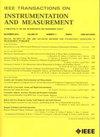Tactile Electronic Skin With Curved Surface Compensation by In Situ Curvature Self-Sensing
IF 5.6
2区 工程技术
Q1 ENGINEERING, ELECTRICAL & ELECTRONIC
IEEE Transactions on Instrumentation and Measurement
Pub Date : 2024-10-23
DOI:10.1109/TIM.2024.3485455
引用次数: 0
Abstract
Tactile electronic skins with flexibility and good conformability have good application prospects in wearable electronics. However, pseudo-signals are generated when the electronic skin is attached to a curved surface, which affects the pressure detection performance of the electronic skin and limits its application. In this article, we developed a tactile electronic skin that compensates for curved surfaces through in situ curvature sensing and established a pressure, curvature-current model for the compensation of the curvature effect of the electronic skin. The electronic skin can compensate for the measured pressure according to the model and realizes a high-precision sensing capability. It consists of Ag/Ecoflex electrodes, pressure-sensitive materials, and a support layer. The Ag/Ecoflex electrodes with curvature sensing were prepared using screen printing and prestretching. The pressure insensitivity mechanism of the electrodes was analyzed. The effects of curvature on the measurement error of electronic skin were investigated. Experimental results suggest that Ag/Ecoflex electrodes with 80% prestretch have a 21.6/cm−1 curvature sensitivity coefficient and insensitivity to pressure at 0–200 kPa. The measurement errors introduced by curvature can be reduced by compensation. As an application, the skin is attached to the human arm for pressure measurement, through which its great potential is therefore highlighted in curved scenarios such as human prostheses, robots, and flexible airplane skins.通过原位曲率自感应实现曲面补偿的触觉电子皮肤
具有柔韧性和良好保形性的触觉电子皮肤在可穿戴电子设备中具有良好的应用前景。然而,当电子皮肤附着在曲面上时,会产生伪信号,从而影响电子皮肤的压力检测性能,限制了其应用。在本文中,我们开发了一种通过原位曲率传感对曲面进行补偿的触觉电子皮肤,并建立了一个压力、曲率-电流模型,用于补偿电子皮肤的曲率效应。电子皮肤可根据模型对测量压力进行补偿,实现高精度传感能力。它由 Ag/Ecoflex 电极、压力敏感材料和支撑层组成。具有曲率传感功能的 Ag/Ecoflex 电极是通过丝网印刷和预拉伸制备的。分析了电极的压力不敏感机制。研究了曲率对电子皮肤测量误差的影响。实验结果表明,预拉伸率为 80% 的 Ag/Ecoflex 电极的曲率敏感系数为 21.6/cm-1,在 0-200 kPa 压力下对压力不敏感。曲率带来的测量误差可以通过补偿来减少。作为一种应用,这种皮肤被连接到人体手臂上进行压力测量,因此它在人体假肢、机器人和柔性飞机蒙皮等曲面应用中的巨大潜力得到了凸显。
本文章由计算机程序翻译,如有差异,请以英文原文为准。
求助全文
约1分钟内获得全文
求助全文
来源期刊

IEEE Transactions on Instrumentation and Measurement
工程技术-工程:电子与电气
CiteScore
9.00
自引率
23.20%
发文量
1294
审稿时长
3.9 months
期刊介绍:
Papers are sought that address innovative solutions to the development and use of electrical and electronic instruments and equipment to measure, monitor and/or record physical phenomena for the purpose of advancing measurement science, methods, functionality and applications. The scope of these papers may encompass: (1) theory, methodology, and practice of measurement; (2) design, development and evaluation of instrumentation and measurement systems and components used in generating, acquiring, conditioning and processing signals; (3) analysis, representation, display, and preservation of the information obtained from a set of measurements; and (4) scientific and technical support to establishment and maintenance of technical standards in the field of Instrumentation and Measurement.
 求助内容:
求助内容: 应助结果提醒方式:
应助结果提醒方式:


